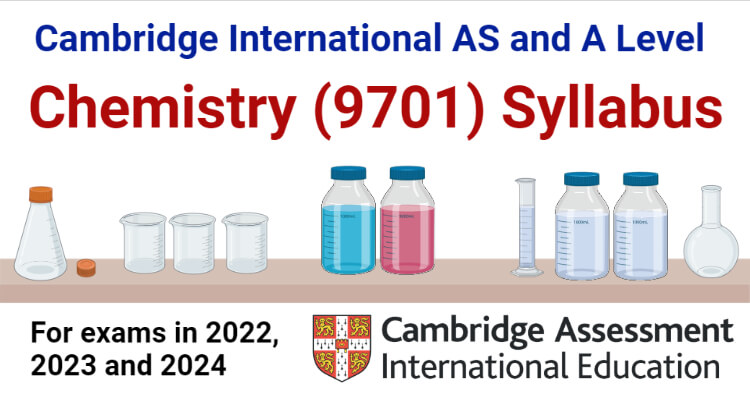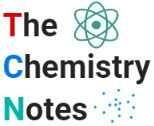Disclaimer: Syllabus and contents on this page are only used for educational purposes. If there are any copyright issues regarding the content, please email us at microbenotes@gmail.com.
This syllabus is for exams in 2022, 2023, and 2024 (Version 3).

Image Credit: Cambridge Assessment International Education.
AS Level Chemistry Subject Content
AS Level Physical Chemistry Syllabus
1. Atomic structure
1.1 Particles in the atom and atomic radius
1.2 Isotopes
1.3 Electrons, energy levels, and atomic orbitals
2. Atoms, molecules, and stoichiometry
2.1 Relative masses of atoms and molecules
2.2 The mole and the Avogadro constant
2.3 Formulae
2.4 Reacting masses and volumes (of solutions and gases)
3. Chemical bonding
3.1 Electronegativity and bonding
3.2 Ionic bonding
3.3 Metallic bonding
3.4 Covalent bonding and coordinate (dative covalent) bonding
3.6 Intermolecular forces, electronegativity, and bond properties
4. States of matter
4.1 The gaseous state: ideal and real gases and pV = nRT
5. Chemical energetics
5.2 Hess’s Law
6. Electrochemistry
6.1 Redox processes: electron transfer and changes in oxidation number (oxidation state)
7. Equilibria
7.1 Chemical equilibria: reversible reactions, dynamic equilibrium
7.2 Brønsted–Lowry theory of acids and bases
8. Reaction kinetics
8.1 Rate of reaction
8.2 Effect of Temperature on reaction rates and the Concept of activation energy
8.3 Homogeneous and heterogeneous catalysts
AS Level Inorganic Chemistry Syllabus
9. The Periodic Table: chemical periodicity
9.1 Periodicity of physical properties of the elements in Period 3
9.2 Periodicity of chemical properties of the elements in Period 3
9.3 Chemical periodicity of other elements
10. Group 2
10.1 Similarities and trends in the properties of the Group 2 metals, magnesium to barium, and their compounds
11. Group 17
11.1 Physical properties of the Group 17 elements
11.2 The chemical properties of the halogen elements and the hydrogen halides
11.3 Some reactions of the halide ions
11.4 The reactions of chlorine
12. Nitrogen and sulfur
AS Level Organic Chemistry Syllabus
13. An introduction to AS Level organic chemistry
13.1 Formulae, functional groups, and the Naming of organic compounds
13.2 Characteristic organic reactions
13.3 Shapes of organic molecules; σ and π bonds
13.4 Isomerism: structural and Stereoisomerism
14. Hydrocarbons
14.1 Alkanes
14.2 Alkenes
15. Halogen compounds
15.1 Halogenoalkanes
16. Hydroxy compounds
16.1 Alcohols
17. Carbonyl compounds
18. Carboxylic acids and derivatives
18.1 Carboxylic acids
18.2 Esters
19. Nitrogen compounds
19.1 Primary amines
19.2 Nitriles and hydroxy nitriles
20. Polymerisation
21. Organic synthesis
21.1 Organic synthesis
AS Level Analysis Syllabus
22. Analytical techniques
22.2 Mass spectrometry
A Level Chemistry Subject Content
A Level Physical Chemistry Syllabus
23. Chemical energetics
23.1 Lattice energy and Born-Haber cycles
23.2 Enthalpies of solution and hydration
23.3 Entropy change, ΔS
23.4 Gibbs free energy change, ΔG
24. Electrochemistry
24.1 Electrolysis
24.2 Standard electrode potentials E⦵; standard cell potentials E⦵cell and the Nernst equation
25. Equilibria
25.1 Acids and bases
26. Reaction kinetics
26.1 Simple rate equations, orders of reaction and rate constants
26.2 Homogeneous and heterogeneous catalysts
A Level Inorganic Chemistry Syllabus
27. Group 2
28. Chemistry of transition elements
28.1 General physical and chemical properties of the first row of transition elements, titanium to copper
28.3 Colour of complexes
28.4 Stereoisomerism in transition element complexes
28.5 Stability constants, Kstab
A Level Organic Chemistry Syllabus
29. An introduction to A Level organic chemistry
29.1 Formulae, functional groups, and the naming of organic compounds
29.2 Characteristic organic reactions
29.3 Shapes of aromatic organic molecules; σ and π bonds
29.4 Isomerism: optical
30. Hydrocarbons
30.1 Arenes
31. Halogen compounds
31.1 Halogen compounds
32. Hydroxy compounds
32.1 Alcohols
32.2 Phenol
33. Carboxylic acids and derivatives
33.1 Carboxylic acids
33.2 Esters
33.3 Acyl chlorides
34. Nitrogen compounds
34.1 Primary and secondary amines
34.2 Phenylamine and azo compounds
34.3 Amides
34.4 Amino acids
35. Polymerisation
35.1 Condensation polymerization
35.2 Predicting the type of polymerization.
35.3 Degradable polymers
36. Organic synthesis
36.1 Organic synthesis
A Level Analysis Syllabus
37. Analytical techniques
37.1 Thin-layer chromatography
37.2 Gas/liquid chromatography
37.3 Carbon-13 NMR spectroscopy
37.4 Proton (1H) NMR spectroscopy
Assessment Details
Paper 1- Multiple Choice
- Written paper, 1 hour 15 minutes, 40 marks
- Forty multiple-choice questions of the four-choice type testing assessment objectives AO1 and AO2.
- Questions are based on the AS Level syllabus content.
Paper 2- AS Level Structured Questions
- Written paper, 1 hour 15 minutes, 60 marks
- Structured questions testing assessment objectives AO1 and AO2.
- Questions are based on the AS Level syllabus content.
Paper 3- Advanced Practical Skills
- Practical test, 2 hours, 40 marks
- This paper tests assessment objective AO3 in a practical context.
- Questions are based on the experimental skills in the Practical assessment section of the syllabus for Paper 3.
Paper 4- A Level Structured Questions
- Written paper, 2 hours, 100 marks
- Structured questions testing assessment objectives AO1 and AO2.
- Questions are based on the A Level syllabus content; knowledge of material from the AS Level syllabus content will be required.
Paper 5- Planning, Analysis, and Evaluation
- Written paper, 1 hour 15 minutes, 30 marks
- Structured questions testing assessment objective AO3.
- Questions are based on the experimental skills of planning, analysis, and evaluation in the Practical assessment section of the syllabus for Paper 5. The context of the questions may be outside the syllabus content.
Reference and Source
https://www.cambridgeinternational.org/Images/554616-2022-2024-syllabus.pdf

The syllabus objectives not shown why???
You can find more details from the link provided in the reference/source section.